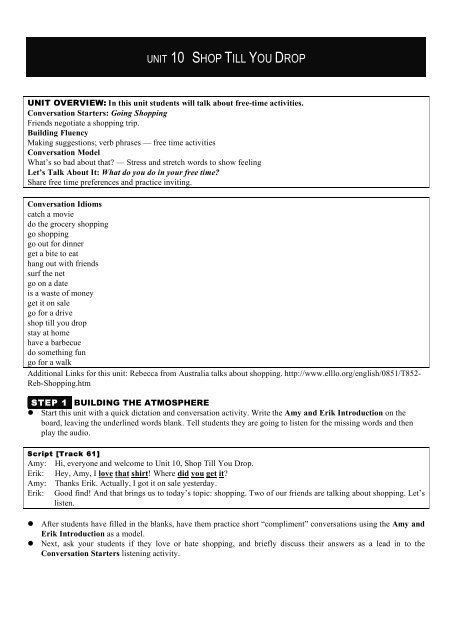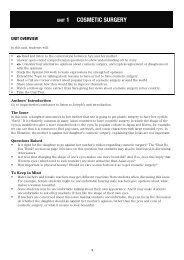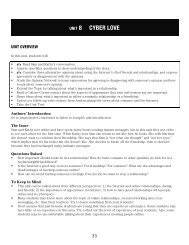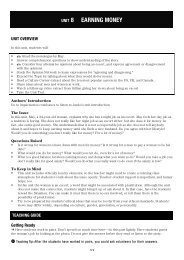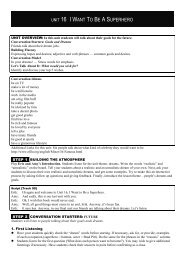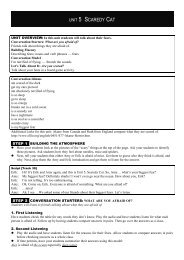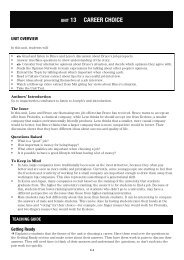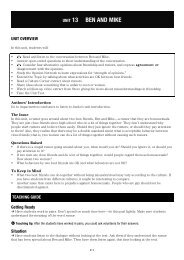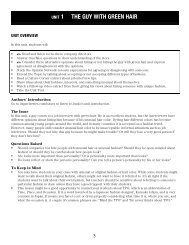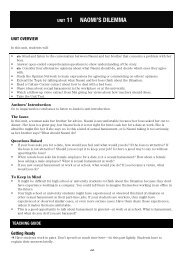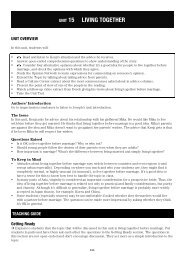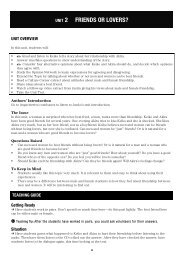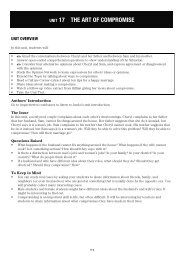UNIT 10 SHOP TILL YOU DROP - Impact Series
UNIT 10 SHOP TILL YOU DROP - Impact Series
UNIT 10 SHOP TILL YOU DROP - Impact Series
You also want an ePaper? Increase the reach of your titles
YUMPU automatically turns print PDFs into web optimized ePapers that Google loves.
<strong>UNIT</strong> <strong>10</strong> <strong>SHOP</strong> <strong>TILL</strong> <strong>YOU</strong> <strong>DROP</strong><br />
<strong>UNIT</strong> OVERVIEW: In this unit students will talk about free-time activities.<br />
Conversation Starters: Going Shopping<br />
Friends negotiate a shopping trip.<br />
Building Fluency<br />
Making suggestions; verb phrases — free time activities<br />
Conversation Model<br />
What’s so bad about that? — Stress and stretch words to show feeling<br />
Let’s Talk About It: What do you do in your free time?<br />
Share free time preferences and practice inviting.<br />
Conversation Idioms<br />
catch a movie<br />
do the grocery shopping<br />
go shopping<br />
go out for dinner<br />
get a bite to eat<br />
hang out with friends<br />
surf the net<br />
go on a date<br />
is a waste of money<br />
get it on sale<br />
go for a drive<br />
shop till you drop<br />
stay at home<br />
have a barbecue<br />
do something fun<br />
go for a walk<br />
Additional Links for this unit: Rebecca from Australia talks about shopping. http://www.elllo.org/english/0851/T852-<br />
Reb-Shopping.htm<br />
STEP 1 BUILDING THE ATMOSPHERE<br />
Start this unit with a quick dictation and conversation activity. Write the Amy and Erik Introduction on the<br />
board, leaving the underlined words blank. Tell students they are going to listen for the missing words and then<br />
play the audio.<br />
Script [Track 61]<br />
Amy: Hi, everyone and welcome to Unit <strong>10</strong>, Shop Till You Drop.<br />
Erik: Hey, Amy, I love that shirt! Where did you get it?<br />
Amy: Thanks Erik. Actually, I got it on sale yesterday.<br />
Erik: Good find! And that brings us to today’s topic: shopping. Two of our friends are talking about shopping. Let’s<br />
listen.<br />
After students have filled in the blanks, have them practice short “compliment” conversations using the Amy and<br />
Erik Introduction as a model.<br />
Next, ask your students if they love or hate shopping, and briefly discuss their answers as a lead in to the<br />
Conversation Starters listening activity.
STEP 2 CONVERSATION STARTERS: GOING <strong>SHOP</strong>PING<br />
Students will listen to two friends negotiating a shopping trip.<br />
1. First Listening<br />
Tell your students they are going to listen to Ken and Emma discuss what they want to do today. Direct their attention<br />
to the pictures and ask them to guess what each person wants to do. Play the audio and have students circle the things<br />
they talk about. Have them check the answers in pairs.<br />
2. Second Listening<br />
Play the audio again and have students answer the questions. Now ask them if they had guessed correctly above.<br />
Have them check their answers in pairs and then go over the answers as a class.<br />
Note: Ken’s “You’ve got me again” indicates that he will go shopping. He says this because he feels like he’s<br />
been cleverly tricked into agreeing to go shopping (again), even though he doesn’t want to go.<br />
Answer Key<br />
First Listening: groceries, go for a drive, shoes, dress, go shopping<br />
Second Listening: 1. b, 2. b, 3. c<br />
BONUS:<br />
Go over the questions. Encourage students to also compare the speakers to other students in class. (“I think Emma is<br />
like Yoko. She also loves to shop for dresses.”)<br />
BONUS ACTIVITY:<br />
Have students compare the best locations to buy the things or do the activities shown in the images in the First<br />
Listening pictures. For each image, students work in pairs and think of an ideal place in their local area to shop for the<br />
item or to do the activity in the image. Then, have them swap pairs and compare or debate their findings.<br />
Script: [Track 62]<br />
Ken: Hey, Emma. Let’s do something fun today.<br />
Emma: Yeah, that sounds good. How about…<br />
Ken: Do you want to go for a drive?<br />
Emma: A drive? You mean, like, in your car?<br />
Ken: Well, ye-ah…we could go out to the lake, or up to…<br />
Emma: Actually, I’d rather go shopping.<br />
Ken: Shopping? Again? You just went shopping last week. I swear, Emma, you could shop till you drop.<br />
Emma: I know, but I need to get a new pair of shoes to go with the dress I bought last week.<br />
Ken: Ah, Emma, you know how I feel about shopping.<br />
Emma: You could learn to love it. I mean, what’s so bad about shopping?<br />
Ken: Everything! It’s a waste of time. It’s a waste of money. And on top of that, it’s just so boring!<br />
Emma: Oh, Ken, maybe there’s no hope for you. OK, I have an idea. Why don’t we go downtown together? We can<br />
drive in your car if you want.<br />
Ken: Uh-huh.<br />
Emma: And then you can go shopping by yourself for a couple of hours, while I look for my shoes. How’s that?<br />
Ken: But what am I going to do for two hours?<br />
Emma: Isn’t there something you need to get?<br />
Ken: Well, I guess I need some groceries.<br />
Emma: All right then, perfect! I’ll go shoe shopping and you can do your grocery shopping. I’ll give you a call when<br />
I’ve found my shoes. How’s that?<br />
Ken: Hah, you got me again!<br />
STEP 3 BUILDING FLUENCY: MAKING SUGGESTIONS<br />
Students will practice ways to make suggestions and invitations, as well as some common free time activities.<br />
1. Expressions<br />
Working individually, have students fill in the blanks. Then go over the answers as a class. Take the time to explain<br />
the following notes before moving on to vocabulary.<br />
Notes:<br />
1, 2 and 4 sound like true suggestions or invitations because they are questions. Expression 3 is also a suggestion,
ut because it is a statement, it comes across as slightly stronger or proactive.<br />
While “Do you want to…” may be considered more “grammatically correct,” “Want to…?” is very commonly<br />
used in conversations. Students should make sure they raise their voice at the end of this expression to indicate<br />
that it’s a question/suggestion/invitation.<br />
Answer Key<br />
1 – go, 2 – going, 3 – go, 4 – go<br />
2. Vocabulary<br />
Working individually, have students match the phrases to the best pictures. Then have students work in pairs to add to<br />
the collocations. See samples below:<br />
1) go for a drive / ride<br />
2) catch a movie / matinee<br />
3) do the grocery shopping / laundry<br />
etc.<br />
Answer Key<br />
1 – d, 2 – j, 3 – h, 4 – g, 5 – i, 6 – b, 7 – e, 8 – k, 9 – c, <strong>10</strong> – f, 11 – a<br />
VOCAB TROUBLESHOOTING:<br />
Catch a movie – go and see a movie<br />
Do the grocery shopping – buy food from a supermarket<br />
Go shopping – to go to a department store to buy things you want (e.g. clothes, furniture, electric products)<br />
Go out for dinner – go to a restaurant to eat dinner<br />
Get a bite to eat – to buy a small meal or snack, especially from a fast food restaurant<br />
HOW THE GRAMMAR WORKS:<br />
Go over the structures as a class. Allow students to practice making sentences using the additional phrases provided in<br />
the “Note.”<br />
3. Let’s Practice<br />
Have students use the sample dialogue to make suggestions about what to do. One option is to put students in pairs<br />
and have them fill up a schedule of things to do each afternoon for the week. When they are finished, have them swap<br />
pairs and then share their plans. They negotiate with their new partner what the better activity is and why.<br />
STEP 4 CONVERSATION MODEL: WHAT’S SO BAD ABOUT THAT?<br />
Students will practice using stress and stretching to express one’s feelings.<br />
Optional Warm Up<br />
Write the following questions on the board.<br />
1) What does the woman suggest?<br />
2) How does the man respond?<br />
3) Why does he feel this way?<br />
Books closed. Direct the students to the questions on the board. Next, have the students listen to the audio and try to<br />
answer the questions above. After listening as needed, students compare answers in pairs and then as a class.<br />
1. Situation<br />
Have your students check the conversation for unknown words, and explain any difficult phrases.<br />
VOCAB TROUBLESHOOTING:<br />
Let’s do something else – Let’s do something different (not shopping)<br />
What’s so bad about shopping? – What don’t you like about shopping?<br />
HOW THE PRONUNCIATION WORKS: STRESS AND STRETCH WORDS TO SHOW FEELING<br />
Explain the unit pronunciation point to your students. This is the fourth unit to consider stress and stretching (also see<br />
Units 2, 6 and 9). In this conversation the male speaker hates shopping and definitely does not want to accept the<br />
female speaker’s suggestion to go shopping on the weekend. In order to express how much he hates shopping and<br />
doesn’t want to go shopping, he stresses and stretches “again,” “else,” “everything” and “and.”
Next, play the conversation model [Track 63] and encourage your students to listen out for the use of stress and<br />
stretching in the conversation.<br />
As a class do a choral practice of this conversation, focusing particularly on the pronunciation point. Say each line<br />
or chunk, and have your students repeat.<br />
EXTRA PRONUNCIATION POINTS: REDUCE AND BLEND SOUNDS<br />
Why don’t we – why don(t) we<br />
What’s so bad about shopping? – wha(t)so ba dabou(t) shopping?<br />
It’s a waste of money – itsa wastov money<br />
And it’s a waste of time – an (d)itsa wastov time<br />
2. Substitution<br />
Have students work individually to connect the phrases in the columns to make a coherent conversation. Then have<br />
students compare answers in pairs.<br />
Answer Key<br />
Stay at home – staying home – so boring<br />
Go out to eat – eating out – too expensive<br />
Go camping – camping – too cold<br />
3. Practice<br />
Have students use the substitution words to practice the conversation. Remind them to use stress and stretching<br />
where appropriate. Have early finishers create their own conversations.<br />
Choose a pair to demonstrate the conversation. Comment on their use of stress and stretching, and offer<br />
pronunciation and intonation advice as necessary.<br />
STEP 5 LET’S TALK ABOUT IT: WHAT DO <strong>YOU</strong> DO IN <strong>YOU</strong>R FREE TIME?<br />
Students will discuss their free time preferences and practice making invitations.<br />
Optional Warm Up:<br />
Divide the class into two teams. Have one student from each team come to the front of the class and sit in chairs<br />
facing the other students. They should be sitting with their backs to the board. Then, write one of the activities from<br />
the activity page on the board (for example, catch a movie). Their teams compete to get their teammate sitting in the<br />
front of the class to guess the word. Students can use words related to the word on the board, but not the words<br />
themselves (for example, theater, popcorn, ticket, etc). The first teammate to produce the phrase gets a point for their<br />
team.<br />
1. Get Ready<br />
Have students complete the free-time activity questionnaire individually. Then, in pairs, have them think of four<br />
additional ideas to write at the bottom and discuss their preferences.<br />
2. Let’s Talk<br />
Have students mingle around the classroom inviting at least 8 different classmates to 8 different activities. Be sure to<br />
model how to do the activity. In the model, it is best to show how to greet someone, bring up the topic of doing<br />
something and closing a conversation before moving on to a new partner. See sample dialogue below:<br />
A: Hey, Bill. How are you?<br />
B: Not bad thanks.<br />
A: Say, I was wondering, are you free this weekend?<br />
B: Yeah, I have no plans.<br />
A: How about going for something to eat?<br />
B: Sure, what do you have in mind?<br />
A: Well, how about Chinese? There is a great new restaurant.<br />
B: Sounds good...<br />
BONUS: Speaking Activity<br />
If time permits, have students try the bonus speaking questions. This could be done as either a pair/group/class<br />
discussion or an extemporaneous speaking exercise.
STEP 6 LANGUAGE AWARENESS<br />
Assign the language awareness activity on page 90 for homework. If necessary, do the first one or two questions<br />
together as a class. Leave 5 or <strong>10</strong> minutes at the beginning of the next class to go through the answers.<br />
Answer Key<br />
1. Yes – “do” becomes “doing” when we use “How about”<br />
2. I’d rather go shopping<br />
3. a new pair of shoes<br />
4. go with<br />
5. on top of that<br />
6. so boring<br />
7. No – We use “during + noun” (during the holiday) and we use “while + subject + verb” (while I was on holiday).<br />
8. How’s that?<br />
9. get<br />
<strong>10</strong>. groceries<br />
STEP 7 ERIK’S CONVERSATION TIP<br />
In the Building Fluency section, students practiced four ways of making suggestions or invitations in English.<br />
However, there are some occasions when we want to be a bit more indirect – for example when asking someone on a<br />
date, or when we think we might be turned down. In these cases we often add phrases like “I was just wondering,” “I<br />
guess you’re probably busy, but…” or “You’ve probably already got plans, but…”<br />
Bonus Activity:<br />
A nice follow up activity to this unit would be to have students practice writing invitation emails using the expressions<br />
learned in the unit. If time permits, they could exchange their invitation emails and also practice writing replies.<br />
STEP 8 <strong>UNIT</strong> TEST<br />
Make copies of the Unit Test for each student. Start by playing the audio for the Listening section (download Track <strong>10</strong><br />
from http://www.elttestcenter.com). Decide whether you give them one or two listenings. Then, allow the students<br />
about 5-<strong>10</strong> minutes to complete the rest of the test. Correct the test in class, and record the score.<br />
AUDIO Script<br />
Am I a shopaholic? Well, I wouldn’t call myself a shopaholic. But, yes, I enjoy going shopping once in a while,<br />
especially for clothes or furniture. I like going with my girlfriend because I find it really hard to make decisions and I<br />
really appreciate her opinion. But she absolutely hates shopping. She says no every time!<br />
Answer Key<br />
Part A.<br />
1. b<br />
2. c<br />
Part B.<br />
3. you want to<br />
4. have<br />
5. catch<br />
6. go shopping<br />
Part C.<br />
7. stayed<br />
8. grocery<br />
9. bite<br />
<strong>10</strong>. expensive


